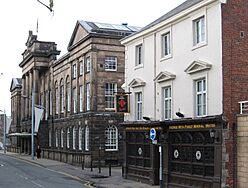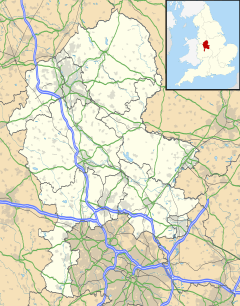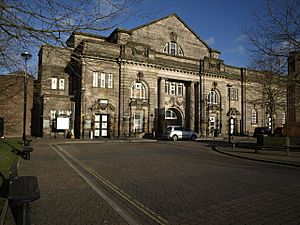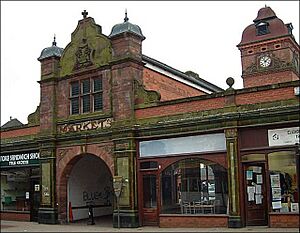Stoke-upon-Trent facts for kids
Quick facts for kids Stoke-upon-Trent
|
|
|---|---|
| Federated Town and District | |
|
|
| OS grid reference | SJ875455 |
| Unitary authority | |
| Ceremonial county | |
| Region | |
| Country | England |
| Sovereign state | United Kingdom |
| Post town | STOKE-ON-TRENT |
| Postcode district | ST4 |
| Dialling code | 01782 |
| Police | Staffordshire |
| Fire | Staffordshire |
| Ambulance | West Midlands |
| EU Parliament | West Midlands |
| UK Parliament |
|
Stoke-upon-Trent, often called Stoke, is one of six towns that make up the city of Stoke-on-Trent in Staffordshire, England. The other towns are Hanley, Burslem, Fenton, Longton, and Tunstall.
Stoke became a self-governing town in 1874. In 1910, these six towns joined together to form the County Borough of Stoke-on-Trent. Later, it became the City of Stoke-on-Trent. Even though Hanley is now seen as the city centre, Stoke has been home to the city's council offices since 1910.
Contents
Why is it Called Stoke?
On April 1, 1910, the town of Stoke joined with others to form the larger area of Stoke-on-Trent. By 1925, this area was officially given city status.
It can be a bit confusing that the town and the larger city share a similar name. The main reason the new city was named "Stoke" is because the city's main offices were located there. Stoke also had the best transport links, like the river, canal, main railway line, and main road, all passing through its centre.
The main railway station was in Stoke, making its name well-known outside the area. So, it made sense to name the new city after this old and familiar town, even if Hanley was the bigger shopping area.
Ideas for New Names
Because the town of Stoke and the city of Stoke-on-Trent have such similar names, some people, especially business leaders, have suggested changing one of the names. Ideas for the town include "Old Stoke" or "Stoke Town." There are also ideas to rename part of Hanley to "Stoke-on-Trent City Centre."
How Stoke Grew and Its Transport
Stoke is located where the River Trent meets the Fowlea Brook. An old Roman road passed through Stoke, which was used for local travel for a long time.
The name "Stoke" comes from an old English word meaning "meeting place" on the Trent River. This was where the first church in the area was built around 670 AD. It was first made of wood, then rebuilt in stone, and is now known as Stoke Minster. A small town grew up around this important church.
In the 1700s, the "Grand Trunk" canal was built along the Trent valley. This canal helped bring china clay from Cornwall to the Potteries area cheaply. It also helped transport finished pottery safely away. Many people who helped build the canal were pottery owners.
In the 1800s, railways also came through the valley. The main Stoke-on-Trent railway station opened on October 9, 1848. Before this, a temporary station was used. Travellers coming to the region would often change trains at Stoke to reach other local towns.
King's Hall: A Grand Building
The King's Hall is a large building with a hall for events, a ballroom, and a theatre. It was built between 1910 and 1911 when the towns joined together. It has a grand stone front facing Kingsway, right behind the town hall.
The King's Hall works well with the town hall, which was built earlier (1834–1850). The whole Town Hall–King's Hall complex is used for the city's main administrative offices, including the Lord Mayor's office. It also hosts many formal events for the city.
Stoke Market: A Place to Shop
Stoke has had markets in different parts of the town since 1818. A market was set up inside the new town hall in the 1830s, but traders didn't like it much. So, in 1845, the market moved to Hide Street. You can still see that building today.
In 1883, the market moved again to a bigger, specially built building on Church Street. This Victorian market was almost completely destroyed by a fire on May 22, 1982. Only the clock tower, entrance arch, fish section, and some shop fronts were saved. The current market opened in 1984 on South Wolfe Street. The old market site, with its clock tower, is now an outdoor area for trading and events. A library and a one-stop shop have also been added there.
The Potteries: A Rich History
In the 1800s, Stoke was famous for its pottery industry, which is why the area is nicknamed "The Potteries." For a long time, the skyline was filled with tall, bottle-shaped kilns used to fire pottery. However, since the mid-1900s, most of these kilns have been taken down because of rules from the Clean Air Act. There were once about 4,000 bottle kilns, but now only about 46 remain. Famous pottery companies from Stoke-upon-Trent include Spode, Copeland, Minton, and Biltons.
Stoke Today: What's Here?
Even though Hanley is now bigger in size, population, and shops, Stoke still has many important places:
- Stoke Minster, a historic church.
- The same (shorter) name as the city itself.
- The main railway station for the area.
- The main campus of Staffordshire University and its library.
- A long-standing arthouse cinema called The Film Theatre.
- A specially built repertory theatre.
- The Trent & Mersey canal and its long-distance bicycle paths (National Cycle Network Route 5).
- The main group of council offices and the council chamber, located around the town hall.
- The King's Hall, a venue for music and events.
- A free public library.
- Both outdoor and indoor markets.
- The Spode Copeland pottery factory, which closed in 2008 but is now part of a big regeneration project.
- The Villas, the first conservation area in Stoke, with several historic Grade II listed houses.
- The Royal Stoke University Hospital and the City General Hospital are nearby. This is one of the largest hospitals in the UK.
- Stoke has a lively music scene, with bands like Deviant UK and a dedicated band rehearsal room.
Some areas or districts within Stoke-upon-Trent include Boothen, Hartshill, Mount Pleasant, Penkhull, and Trent Vale.











